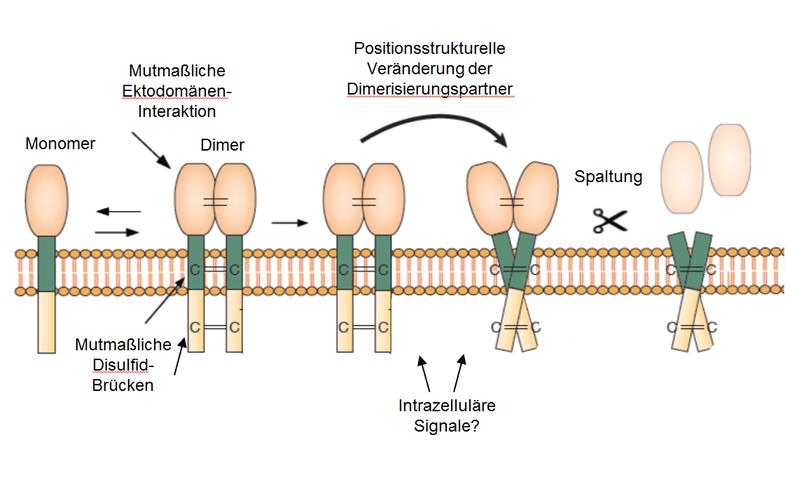

License for cutting: Factor-precursor-producing cells determine if and when ectodomain cleavage may occur to activate growth factors.
[Graphic: Liseth M Parra / FLI]
Researchers from German Leibniz Institute for Age Research and Harvard University, US, showed that the factor-precursor-producing cells themselves define if cleavage may occur. This is decided by intracellular signaling. Interfering with defined signaling in cells producing cancer growth factors could lead to a new way of cancer treatment.
As cancer cells proliferate in an unlimited way, they need to be supplied with oxygen and nutrients. For their growth and the formation of blood vessels, so-called growth factors are required. These hormone-like proteins are activated by the shedding of transmembrane precursor proteins that have to be cleaved on the outside of the plasma membrane by specialized enzymes.
In the human body, mainly three “cleavage enzymes” are responsible for ectodomain shedding of hundreds of growth factors. Hindering one of these enzymes from cleaving would certainly suppress the production of growth factors related to tumorigenesis, but would have severe side-effects: a lot of life-essential molecules would also be inhibited. Since ectodomain cleavage is highly important for homeostasis of the organism, it needs to be tightly regulated with respect to both its overall abundance and time course.
Now, in a collaborative project, researchers from German Leibniz Institute for Age Research (FLI) in Jena and renowned Harvard University in Cambridge, US, showed that obviously the precursor proteins themselves dictate if and when the “scissor”-enzymes may cut. Signal processing in the intracellular domain of the precursor-protein-producing cells is responsible for modifications that likely induce a relative positional change of the dimerization partners and, in the end, allow cleavage.
This is individually different for each precursor protein. The collaborators from Jena and Cambridge already found many details of the mechanism to explain how the intracellular domain modification communicates with the ectodomain of the substrate to allow for cleavage to occur, e.g. releasing growth factors linked to breast cancer (Epidermal Growth Factor family) and Neuregulin which is important for neuro-regeneration, as well as cleavage of a protein relevant for metastasizing of cancer cells. The latest publication in the “Journal of Biological Chemistry” now was nominated as one of the best 50 out of this year’s 6.000 publications.
“Our research results offer a new way of suppressing growth factors related to cancer cell proliferation”, Prof. Dr. Peter Herrlich, former scientific director and now associated researcher at FLI, explains. Instead of blocking the cleavage enzymes and condoning side-effects, the intracellular signal processing for single precursor proteins may be inhibited in order to specifically knock out the growth factors required by individual cancer types.
Publication.
Hartmann M, Parra LM, Ruschel A, Lindner C, Morrison H, Herrlich A, Herrlich P. Inside-out Regulation of Ectodomain Cleavage of Cluster-of-Differentiation-44 (CD44) and of Neuregulin-1 Requires Substrate Dimerization. Journal of Biological Chemistry (2015), DOI 10.1074/jbc.M114.610204.
Contact.
Dr. Evelyn Kästner
Leibniz Institute for Age Research – Fritz Lipmann Institute (FLI)
Beutenbergstr. 11, D-07745 Jena
Tel.: +49 3641-656373, Fax: +49 3641-656351, E-Mail: presse@fli-leibniz.de
Background Information
The Leibniz Institute for Age Research – Fritz Lipmann Institute (FLI) is the first German research organization dedicated to biomedical aging research since 2004. More than 330 members from over 30 nations explore the molecular mechanisms underlying aging processes and age-associated diseases. For more information, please visit http://www.fli-leibniz.de.
The Leibniz Association connects 89 independent research institutions that range in focus from the natural, engineering and environmental sciences via economics, spatial and social sciences to the humanities. Leibniz Institutes address issues of social, economic and ecological relevance. They conduct knowledge-driven and applied basic research, maintain scientific infrastructure and provide research-based services. The Leibniz Association identifies focus areas for knowledge transfer to policy-makers, academia, business and the public. Leibniz Institutes collaborate intensively with universities – in the form of “WissenschaftsCampi” (thematic partnerships between university and non-university research institutes), for example – as well as with industry and other partners at home and abroad. They are subject to an independent evaluation procedure that is unparalleled in its transparency. Due to the institutes’ importance for the country as a whole, they are funded jointly by the Federation and the Länder, employing some 18,100 individuals, including 9,200 researchers. The entire budget of all the institutes is approximately 1.64 billion EUR. See http://www.leibniz-association.eu for more information.
http://www.fli-leibniz.de – Website Leibniz Institute for Age Research – Fritz Lipmann Institute (FLI) Jena












